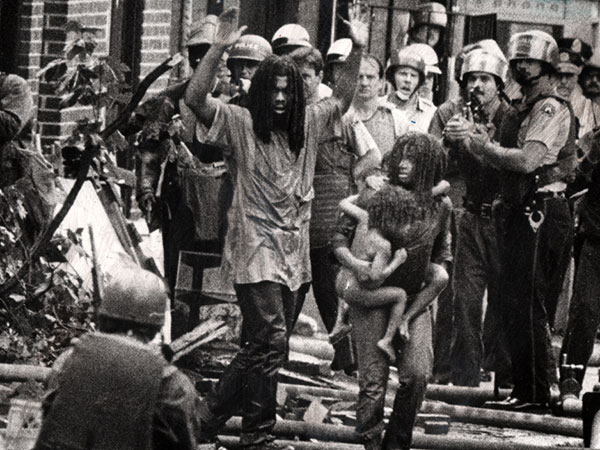Film Review: “Let the Fire Burn” — An Important Political Film
Historic footage—from newsreels, TV stations once-live coverage, from several investigating commissions- has been edited, brilliantly into a coherent, important political film.
Let the Fire Burn, directed by Jason Osder. At the Kendall Square Cinema and other movie houses around New England.

“LET THE FIRE BURN”: MOVE members and children emerge from their “headquarters” in a 1978 confrontation. Photo: Sam Psoras / Philadelphia Daily News.
By Gerald Peary
Bertolt Brecht famously said that an audience at a play (or film) should be considered like a trial jury, invited to make educated judgments based on evidence dramatized before them. Jason Osder’s documentary, Let the Fire Burn, commendably follows that strategy, allowing viewers to unravel what happened in Philadelphia the fatal night of May 13, 1985, and to decide who is guilty. There’s no voice-over for the film providing the omniscient “truth,” and no follow-up interviews with the surviving participants to tie up everything with a contemporary perspective. Instead, Let the Fire Burn sends us back in a time capsule to make sense of footage shot almost thirty years ago, buried in vaults. That historic footage—from newsreels, TV stations once-live coverage, from several investigating commissions- has been edited, brilliantly into a coherent, important political film.
This is the story of an African-American politically based group, MOVE, and its total annihilation by the Philadelphia police department. In 1978, an attack on a MOVE group house ended with a dead officer and nine MOVE members sentenced to cruelly long jail sentences for allegedly participating in the murder. (Some claim he was actually killed by friendly fire.) On May 13, 1985, the Philadelphia police invaded a second MOVE house, capped by a police helicopter dropping a bomb on the MOVE rooftop. When the building turned to flame, Police Commissioner Gregore Sambor gave his famous order to the Philadelphia Fire Commisioner: “Let the fire burn.”
Burn it did. Six adult MOVE members perished in the fire. Worse, five children of MOVE members also died in the flames.
Many of the police who are seen on screen are stereotyped white-guy hard-asses, just the fuzz who you could imagine beating up people of color for the pure pleasure. They got their training, and permission to be enforcers, under former mayor (and ex-cop) Frank Rizzo, who was Democrat-conservative school of Chicago’s Richard Daley. These Rizzo loyalists had nothing for disdain for the new 1980s mayor, Wilson Goode, Philly’s first African-American hizzoner. When Goode from his headquarters ordered the fire to be put out, the police department flagrantly ignored his command.
Let the Fire Burn offers a damning portrait of the Philadelphia Police Department, and, in my eye, it can’t be read any other way than cops got away with mass murder. But what makes the film far more interesting as a film is that the MOVE people are themselves anything but innocents. MOVE are the most tainted, dubious of leftist street heroes. I, the jury, offer my judgment: despite their claim otherwise, they were a cult, and a pernicious one, run top-to-bottom by John Africa, their tyrannical leader. Look how the children were treated: we see (news footage) them standing about, naked and stunned with swollen bellies. They were forced to eat only raw food, to have no toys or television, to memorize and shout out abstract rhetorical chants which reflected the paranoia and misanthropy of the MOVE organization.
It’s important to note that it was African-American citizenry, MOVE’s West Philadelphia neighbors, who petitioned government officials to intervene. They had been besieged day and night by Orwellian megaphones attached to the MOVE house spewing words of hate onto everyone on the outside, black and white, calling them “motherfuckers.” And there were complaints of lack of sanitation from the MOVE house and, most important, maltreatment of children.
My conclusion? The police were in the right following Mayor Goode’s original order, to remove the MOVE people from their dystopian house. They were a public nuisance, a public nuisance. But it needed to be done non-violently. What actually happened was, instead, unmitigated homicide, though, of course, no cop, no police commissioner, ever was charged with any misdeed. Meanwhile, the MOVE 9 from the 1978 incident remain, 35 years after, unpardoned in jail.
Gerald Peary is a professor at Suffolk University, Boston, curator of the Boston University Cinematheque, and the general editor of the “Conversations with Filmmakers” series from the University Press of Mississippi. A critic for the late Boston Phoenix, he is the author of 9 books on cinema, writer-director of the documentary For the Love of Movies: the Story of American Film Criticism, and a featured actor in the 2013 independent narrative Computer Chess.

